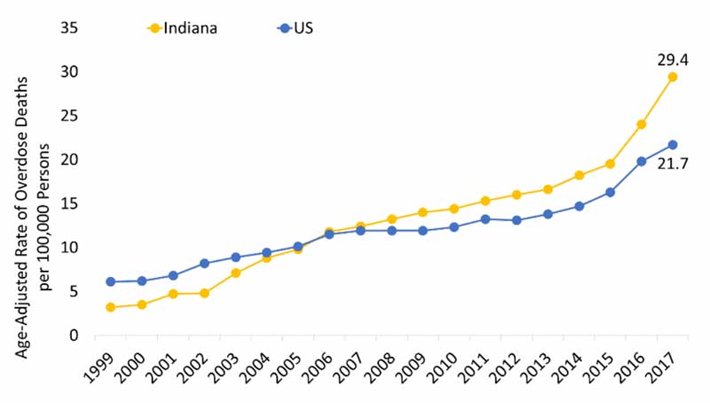Is Increasing Unemployment Associated with Increasing Drug Use and Overdose Statistics?

It might come as no surprise that researchers have found that the closing of major American manufacturing facilities correlates with an increase in opioid overdose mortality. It is completely logical that a person who loses a job, home and hope might be susceptible to overuse of alcohol or indulgence in addictive drugs. And for too many of those people, indulgence in opioids like painkillers, heroin or fentanyl leads to a loss of life from overdose.
This correlation was the logical conclusion published in the Journal of the American Medical Association Internal Medicine in December 2019. Researchers compiled a list of U.S. automobile assembly plants that closed between 1999 and 2016. They then counted up the opioid overdose deaths in the counties that housed those plants. One hundred twelve counties were included in this study. The researchers found a significant increase in opioid deaths in these counties.
The researchers also compared the deaths in these counties with overdose deaths in counties that did not experience plant closures. Here’s how these counties compared five years after the plants closed:
- Counties with closures 20.1 deaths per 100,000 population
- Counties with no closures 12.8 deaths per 100,000 population
The population that suffered the most losses was non-Hispanic white men aged 18 to 34 years.
Case Study: Gary, Indiana

The rough history of this American city serves as a real-life example of the phenomenon documented in this research project. At one time, Gary was a thriving steel-producing city a few miles from Chicago. On the shores of Lake Michigan, a vast area was devoted to a U.S. Steel plant. In fact, the city itself was founded to house the 25,000 people working at this plant.
By the 1980s, U.S. Steel was losing an estimated $1 million per day, according to the Chicago Tribune. While it made a comeback for a while, eventually, 20,000 people were laid off and many of those people moved away to find work elsewhere. The city began to deteriorate as it lost the taxes needed to maintain facilities and public buildings. Empty homes and office buildings decayed.
By 1994, Gary had been declared the murder capital of the country. The homicide rate was 91 murders per 100,000 residents. The steel plant was only employing 7,000 people and, of course, the businesses that had once been supported by all those people who were now unemployed also struggled.
When there was no work to be found, some of these people turned to drug trafficking and some of them turned to drug-use to blot out the pain of their damaged lives.
As the city continued to deteriorate, the number of drug overdose deaths began to climb. It wasn’t until 2007 that they finally exceeded the rate of loss experienced by the country as a whole. The numbers continued to climb after that until they reached a rate of 29.4 overdose losses per 100,000 persons in the area.

By 2013, the population in the city had fallen to half of what it was in 1960. That year, the number of children entering the welfare system, primarily because of parental substance abuse, climbed 30% in a single year.
The tragic story of this city and the people affected by the plant shutdown and the city’s deterioration brings the researchers’ results to vivid life. Preventing drug use, addiction and overdose losses has much to do with the economic success of a city and its residents. With honest work, there can be hope for the future. Without hope, drugs and alcohol may have far too much appeal to some individuals.
Sources:
- https://jamanetwork.com/journals/jamainternalmedicine/fullarticle/2757788
- https://www.chicagotribune.com/news/ct-xpm-1996-02-26-9602260041-story.html
- https://www.indystar.com/story/opinion/2018/03/02/when-gary-indiana-model-city/388997002/
- https://www.chicagotribune.com/news/ct-xpm-1994-01-03-9401030009-story.html
- https://www.inphilanthropy.org/sites/default/files/Richard%20M.%20Fairbanks%20Opioid%20Report%20September%202016.pdf
Reviewed by Claire Pineclli, ICAADC, CCS, LADC, RAS, MCAP
